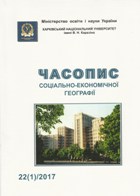Spatial features, problems and prospects for formation of united territorial communities in Kharkiv region
Abstract
In modern conditions of our country great attention of scientists devoted to the problems of improvement of territorial organization regional settlement systems. The process of decentralization of power creates entirely new conditions for the life of the regions of Kharkiv region. Formation of local communities should be focused on providing the public with maximum number of quality services. In every region ofUkrainethere are territories, such as cities, that have a more intense level of development, have better living conditions than the peripheral rural areas. That is why the regional development planning is an important for aligning the economic capacity of the weaker regions on the regional level.
The greatest socio-economic level of development will stand out of the community, which include large villages and townships, with important industrial and social facilities for the population with necessary services. With transport links and communication with the regional center of these towns can become new centers of economic development, «growth poles» of the region.
Territorial communities legally formed in the Kharkiv region, according to the conditional basis of «preferred habitats residents» divided into: predominantly rural, rural-urban, and predominantly urban. Compared with other regions, the formation of local communities in Kharkiv region is quite slow, which indicates the existence of a significant number of problems. Important issues of formation of local communities in Kharkiv region are: complexity, diversity reform mentality of the population, the uncertainty of development priorities of communities. Among perspectives can be defined: two-level direct funding from the state, local budgets presence in the resource base, and a number of preferences of additional features to attract direct investment.
Downloads
References
2. Baranovskyi, M. O. (2016) Demohrafichnyi potentsial tsentriv terytorialnykh hromad regioniv Ukrainskoho Polissya yak vazhlyvyi chynnyk efektyvnosti administratyvno-terytorialnoi reformy [Demographic potential centers of local communities woodlands Ukrainian regions as an important factor in the efficiency of the administrative and territorial reform]. Region – 2016: strategiya optymalnoho rozvytku: materialy mizhnarodnoi naukovo-praktychnoi konferentsii. – Kharkiv: KhNU imeni V.N. Karazina, 20-25.
3. Golikov, A.P. (2011). Kharkovskaya oblast: Priroda, naselenie, khozyaystvo [Kharkiv region: nature, population, economy], Biznes Inform, 288.
4. Dzhaman, V.O. (2003). Regionalni systemy rozselennya: demografichni aspekty [Regional settlement system: demographic aspects]. Chernivtsi: Ruta, 392.
5. The Law of Ukraine (2015) «On a voluntary association of local communities» (Verkhovna Rada (VVR), 2015, number 13, st. 91).
6. Zastavetska, L.B. (2015). Problemy zdiysnennya administratyvno-terytorialnoi reformy v Ukraini [The problems of administrative-territorial reform in Ukraine]. Materialy Vseukrainskoyi konferentsii z uchastyu zakordonnykh uchenykh, prysvyachenoi 70-richchyu kafedry ekonomichnoi i sotsialnoi geografii LNU imeni Ivana Franka. Lviv: Lvivskyi natsionalnyi universytet imeni Ivana Franka, 98-103.
7. Lappo, G.M. (1997). Geografiya gorodov [Geography of cites]. Publishing Center for Humanities VLADOS, 480.
8. Melnychuk, S., Ostapenko, P. (2016). Detsentralizatsiya vlady: reforma № 1 (analitychni zapysky) [Decentraliza-tion of power: the reform №1 (analytical notes)]. Kyiv: TsOP «Hlobus» FOP Kravchenko Ya.O. – 35 s.
9. Niemets, K.A., Kravchenko, K.O. (2015). Rol ta znachennya zaselensko-rozselenskykh protsesiv dlya rozvytku sotsiogeosystemy Kharkivskoi oblasti [The role and importance of settelment processes for development of Kharkiv region socialgeosystems]. Chasopys sotsialno-ekonomichnoi geografii, 19(1), 54-59.
10. Niemets, L.M., Niemets, K.A., Segida, K.Yu. (2012). Demografichnyi rozvytok Kharkivskoho regionu [Demographic development of Kharkiv region]. Kharkiv, KhNU imeni V.N. Karazina, 200.
11. Oliynyk, Ya.B., Ostapenko P.O. (2016). Formuvannya spromozhnykh terytorialnykh hromad v Ukrayini: perevahy, ryzyky, zahrozy [Formation of capable local communities in Ukraine: benefits, risks, threats]. Ukrainskyi geografichnyi zhurnal, 4, 37-44.
12. Official website of the Main Statistical Office in Kharkiv region. Available at: http://uprstat.kharkov.ukrtel.net
13. Official website of Decentralized power reforms in Ukraine. Available at: http://decentralization.gov.ua
14. The project of Perspective plan (2015) of forming the community areas of the Kharkiv region, endorsed by the extraordinary XXXVI session of the Kharkiv Regional Council. Decision №1226-VI of June 18 of 2015.
15. Segida, K.Yu., (2013). Rozselennya naselennya Kharkivskoi oblasti: terytorialnyi aspekt [Settling in Kharkiv region: territorial aspect]. Journal of V.N. Karazin Kharkiv National University: Scientific research journal, 17, 165-169.
Copyright (c) 2017 Катерина Кравченко

This work is licensed under a Creative Commons Attribution 4.0 International License.




